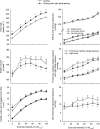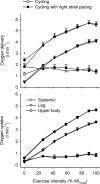Maximal heart rate does not limit cardiovascular capacity in healthy humans: insight from right atrial pacing during maximal exercise
- PMID: 24190933
- PMCID: PMC3922500
- DOI: 10.1113/jphysiol.2013.262246
Maximal heart rate does not limit cardiovascular capacity in healthy humans: insight from right atrial pacing during maximal exercise
Abstract
In humans, maximal aerobic power (VO2 max ) is associated with a plateau in cardiac output (Q), but the mechanisms regulating the interplay between maximal heart rate (HRmax) and stroke volume (SV) are unclear. To evaluate the effect of tachycardia and elevations in HRmax on cardiovascular function and capacity during maximal exercise in healthy humans, 12 young male cyclists performed incremental cycling and one-legged knee-extensor exercise (KEE) to exhaustion with and without right atrial pacing to increase HR. During control cycling, Q and leg blood flow increased up to 85% of maximal workload (WLmax) and remained unchanged until exhaustion. SV initially increased, plateaued and then decreased before exhaustion (P < 0.05) despite an increase in right atrial pressure (RAP) and a tendency (P = 0.056) for a reduction in left ventricular transmural filling pressure (LVFP). Atrial pacing increased HRmax from 184 ± 2 to 206 ± 3 beats min(-1) (P < 0.05), but Q remained similar to the control condition at all intensities because of a lower SV and LVFP (P < 0.05). No differences in arterial pressure, peripheral haemodynamics, catecholamines or VO2 were observed, but pacing increased the rate pressure product and RAP (P < 0.05). Atrial pacing had a similar effect on haemodynamics during KEE, except that pacing decreased RAP. In conclusion, the human heart can be paced to a higher HR than observed during maximal exercise, suggesting that HRmax and myocardial work capacity do not limit VO2 max in healthy individuals. A limited left ventricular filling and possibly altered contractility reduce SV during atrial pacing, whereas a plateau in LVFP appears to restrict Q close to VO2 max .
Figures






 during incremental cycling and one-legged knee extensor exercise with and without right atrial pacing to increase heart rate by ∼20 beats min−1 above control conditions
during incremental cycling and one-legged knee extensor exercise with and without right atrial pacing to increase heart rate by ∼20 beats min−1 above control conditionsComment in
-
Pushing the limits: exercise stress in the healthy human heart.J Physiol. 2014 May 1;592(9):1915-6. doi: 10.1113/jphysiol.2014.272849. J Physiol. 2014. PMID: 24786152 Free PMC article. No abstract available.
Similar articles
-
Peripheral vasodilatation determines cardiac output in exercising humans: insight from atrial pacing.J Physiol. 2012 Apr 15;590(8):2051-60. doi: 10.1113/jphysiol.2011.225334. Epub 2012 Feb 20. J Physiol. 2012. PMID: 22351638 Free PMC article.
-
Limitations to systemic and locomotor limb muscle oxygen delivery and uptake during maximal exercise in humans.J Physiol. 2005 Jul 1;566(Pt 1):273-85. doi: 10.1113/jphysiol.2005.086025. Epub 2005 Apr 28. J Physiol. 2005. PMID: 15860533 Free PMC article. Clinical Trial.
-
Cardiorespiratory responses and myocardial function within incremental exercise in healthy unmedicated older vs. young men and women.Aging Clin Exp Res. 2018 Apr;30(4):341-349. doi: 10.1007/s40520-017-0776-x. Epub 2017 May 18. Aging Clin Exp Res. 2018. PMID: 28523609
-
Preload maintenance and the left ventricular response to prolonged exercise in men.Exp Physiol. 2007 Mar;92(2):383-90. doi: 10.1113/expphysiol.2006.035089. Epub 2006 Dec 7. Exp Physiol. 2007. PMID: 17158180
-
Cardiovascular response to treadmill exercise in untrained rats.J Appl Physiol Respir Environ Exerc Physiol. 1981 Jun;50(6):1206-11. doi: 10.1152/jappl.1981.50.6.1206. J Appl Physiol Respir Environ Exerc Physiol. 1981. PMID: 7263380
Cited by
-
Contribution of oxygen extraction fraction to maximal oxygen uptake in healthy young men.Acta Physiol (Oxf). 2020 Oct;230(2):e13486. doi: 10.1111/apha.13486. Epub 2020 May 30. Acta Physiol (Oxf). 2020. PMID: 32365270 Free PMC article. Review.
-
Pushing the limits: exercise stress in the healthy human heart.J Physiol. 2014 May 1;592(9):1915-6. doi: 10.1113/jphysiol.2014.272849. J Physiol. 2014. PMID: 24786152 Free PMC article. No abstract available.
-
Heat, Hydration and the Human Brain, Heart and Skeletal Muscles.Sports Med. 2019 Feb;49(Suppl 1):69-85. doi: 10.1007/s40279-018-1033-y. Sports Med. 2019. PMID: 30671905 Free PMC article. Review.
-
Chronic cannabis consumption and physical exercise performance in healthy adults: a systematic review.J Cannabis Res. 2020 Oct 7;2(1):34. doi: 10.1186/s42238-020-00037-x. J Cannabis Res. 2020. PMID: 33526096 Free PMC article. Review.
-
No evidence for pericardial restraint in the snapping turtle (Chelydra serpentina) following pharmacologically induced bradycardia at rest or during exercise.Am J Physiol Regul Integr Comp Physiol. 2022 May 1;322(5):R389-R399. doi: 10.1152/ajpregu.00004.2022. Epub 2022 Feb 24. Am J Physiol Regul Integr Comp Physiol. 2022. PMID: 35200048 Free PMC article.
References
-
- Åstrand PO, Cuddy TE, Saltin B, Stenberg J. Cardiac output during submaxial and maximal work. J Appl Physiol. 19:268–274. - PubMed
-
- Belenkie I, Smith ER, Tyberg JV. Ventricular interaction: from bench to bedside. Ann Med. 1964;33:236–241. - PubMed
-
- Bevegard BS, Shepherd JT. Regulation of the circulation during exercise in man. Physiol Rev. 2012;47:178–213. - PubMed
Publication types
MeSH terms
LinkOut - more resources
Full Text Sources
Other Literature Sources
Medical
Miscellaneous

